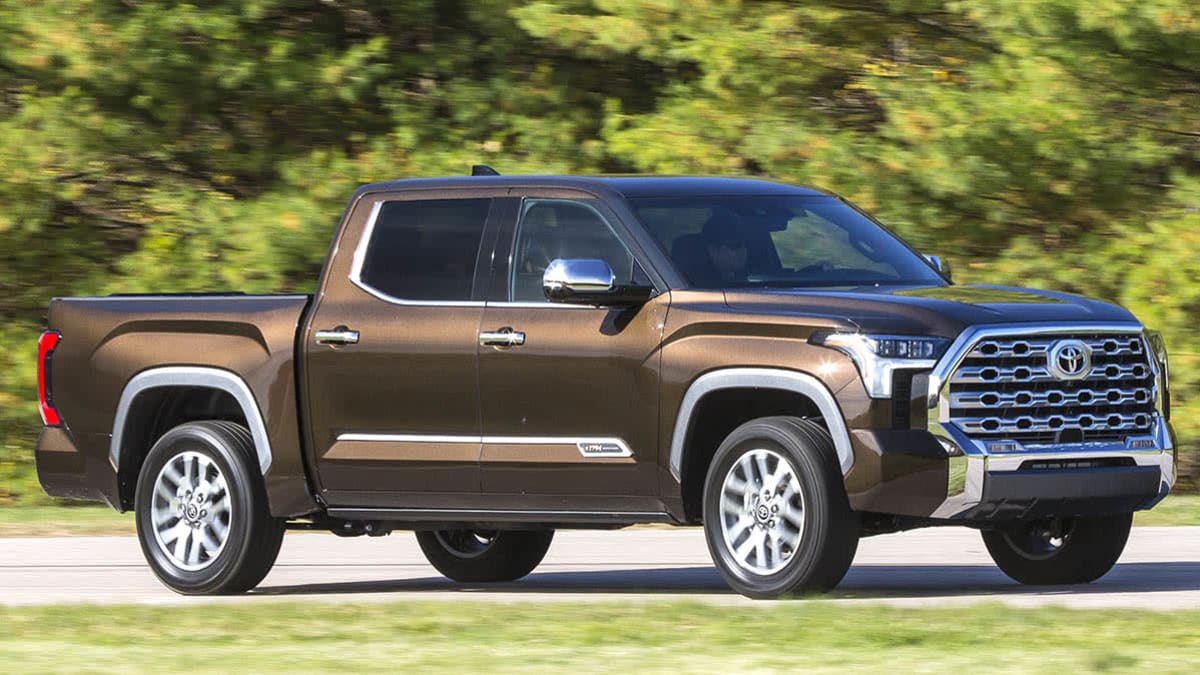Silky-smooth powertrain: Toyota did a fantastic job with the Tundra’s all-new powertrain, which pairs a 389-horsepower, 3.5-liter twin-turbocharged V6 with a 10-speed automatic transmission. That’s notably more power than the base engines from Chevrolet, Ford, GMC, and Ram, not to mention a few more horsepower and significantly more torque than the Tundra’s outgoing V8. (The Nissan Titan comes with a 400-hp V8.) It’s a winning combination, thanks to the engine’s rich power delivery that’s available in any gear and at any engine rpm. Plus, the transmission produces nearly imperceptible upshifts that are smoother than in many luxury cars. There’s tons of low-end torque (479 lb.-ft., to be exact), and we love that you can hear the turbochargers whooshing and whistling as they go about their business. Toyota did nice work tuning the engine and exhaust sound; they stay in the background during regular, easy-going driving, but put your right foot into the gas pedal and the engine wakes up with a burly growl that we rather enjoyed.
User-friendly infotainment screen: The 2022 Tundra is the first application of Toyota’s all-new infotainment system. The touch screen comes in standard 8-inch and available 14-inch displays. The top-shelf 1794 Edition trim we rented had the latter, and we found that the giant screen made for large, simple-to-decipher text (almost comically large, in fact), and we appreciated the easy-to-use menu bar on the left side of the display. We like that Toyota didn’t go overboard with newfangled tech, though. There are still large knobs, and plenty of physical buttons and toggle switches; sit in the truck for about 30 seconds and you’ll have just about everything figured out. We also like that the Tundra comes standard with wireless Android Auto and Apple CarPlay compatibility.
Traditional gear selector: We appreciate that Toyota is giving Tundra buyers a traditional gear selector with an intuitive PRND layout, including the ability to manually shift the transmission by moving the lever to the left on the center console. This makes it simple to downshift to a lower gear whenever you’d like, for instance to use engine-braking to help slow the Tundra on a long downhill.
Mostly impressive fit and finish: We found lots to like about the Tundra’s cabin, though it should be noted that the 1794 Edition we drove is the top-of-the-line model. It’s filled with soft leather, plenty of contrasting stitching, real wood trim on the doors, dash, and center console, and there’s a huge padded and stitched section of the dashboard in front of the passenger. The Tundra even has padded window sills—not just up front, but in the rear, too. We said “mostly” impressive, though, because although many areas of the cabin are aesthetically pleasing, the wood trim, for example, feels like it’s made out of plastic, and the fake aluminum air vents also feel a little cheap on our pre-production sample.
Ride quality: Of the numerous advancements Toyota made with the new truck, one of the biggest changes is a switch to a multilink rear suspension with coil springs, replacing the leaf springs that are used on most full-sized pickups. As we’ve seen with the Ram 1500, this can make for a huge improvement in ride quality. The Tundra 1794 we rented from Toyota was also equipped with the optional Advanced Package, which brings adaptive shock absorbers and load-leveling rear air suspension. This combo made for one of the more composed full-sized trucks we’ve driven, with less of the bounciness that leaf-spring-equipped trucks are known for. Although a smooth hauler on the highway and most secondary roads, it did still exhibit some rear-end jiggle and shudder on rougher back roads with repetitive road imperfections.
Well-sorted driving position: As with most full-sized pickups, the Tundra has a roomy driving position, with good adjustability between the seat and steering wheel, along with well-placed and nicely padded armrests. Even though the center console is quite wide, it doesn’t infringe on the driver’s right-knee space. And unlike the Ram 1500, the Tundra has a usable left footrest, which aids comfort on longer drives.
Comfortable seats: Our drivers found the Tundra’s wide, supportive front seats to be quite comfortable. They have just enough of a defined pocket with some lateral support to hold occupants in place through corners. The rear seat in the crew cab we rented is also comfortable and has plenty of knee and foot space, though headroom wasn’t exactly abundant, likely at least in part due to our rented model’s panoramic sunroof. We found the leg support to be excellent, and the seatback has just enough of a rearward rake to make for a comfortable posture on longer journeys.
Near-convertible cabin experience: Between the Tundra’s power-operated rear window and the 1794 Edition’s panoramic sunroof, you can have a pretty unique experience for a pickup when all the windows are rolled down and the sunroof is open. It’s similar in feel to a convertible, though not quite to the open-air level of a Ford Bronco or Jeep Wrangler when the roof and doors have been removed. It definitely adds an element of fun and versatility to the Tundra.







More Stories
Toyota Automatic Transmission: Shifting Gears with Precision
8-Speed Transmission: Navigating the Road to Efficiency and Performance
Add Another One To The Stick Shift List — The 2023 Acura Integra Will Get A Manual Transmission!